Table of Contents
Motivation
A few days ago, I was working on a UI framework (in rust btw) for a personal project; abruptly, I decided to check my group chat and noticed a screenshot of a question from our university’s anonymous forum, Fizz. As it so happened, the question was a math problem–instantly, it became clear to me that I was nerd sniped (as any math major would). The question was simple and one you have probably thought about at some point in your life:
Do yall think there is a person at rice for every birthday in the year? Like do you think every birthday is represented in the student body?
– Anonymous
Not only that, but it was a classic problem in probability theory! Unfortunately, by the time I saw the question, someone had posted a pretty good answer (funnily enough, someone thought I was the one who anonymously posted the answer). Alas, my nerd-sniped brain was already in full gear, so instead, I am taking this as an opportunity to polish my writing skills 😎. Join me as I walk you through my (hopefully rigorous) exploration of this classic problem.
The Problem and possible leads
In all honestly, this question is fun and can be approached in many ways. Clearly, a trivial solution would involve me, a rice student, having 365 (.25?) friends and checking if each has a different birthday. In the best case, the answer is yes; in the worst case, the answer is no. Unfortunately, I spend most of my time at the library, so such a method would be infeasible; a more rigorous approach is desirable. As a math major, I have found abstraction often easier to work with than a specific case. Naturally, we’ll start by abstracting the problem to a more general form and then returning to the original problem.
If you are familiar with continuous probability theory, perhaps you’ve heard about the Birthday Paradox. The paradox states that for a random group of 23 people, there is a 50% chance that two people share the same birthday (surprising, I know). While this is not the same problem as our question, they are tangentially related! Hence, we will use some of the same techniques (notably counting 😭). Let’s rephrase the question with some assumptions for our first lead!
“Do you think it’s likely that a collection of Rice University students would include at least one student with each possible birthday? Assuming each birthday is equally likely, how many students would be needed to expect that every day of the year, 365 days, is someone’s birthday?”
— Problem 1.1
The most important part of this rephrasing is the assumption (a restriction which we will remove later) of equally likely birthdays and the number of days. Moreover, while the rephrasing is a bit awkward to some, to others, it may remind them of another problem: The Coupon Collector!
The Coupon Collector Problem and Expected Value
Now, I’m not a computer scientist, so I won’t simply “reduce” the problem and call it a day. First, the goal of the coupon collector problem is to determine the expected number of coupons needed to collect all coupons. Instead of coupons, we deal with birthdays and quantify the number of students needed to ensure having all birthdays. In other words, we are trying to calculate the expected number of students required to have all birthdays, which is precisely Problem 1.1!
The idea is simple: keep adding students one by one until you have all birthdays. Following this process, you notice that the first student is guaranteed a unique birthday. Moreover, each new student has a probability of $\frac{x}{365}$ of having a new birthday, where $x$ is the number of unique birthdays left. In contrast, the expected probability of how many students you have to go through until you see a new birthday is the reciprocal probability of seeing a new birthday, i.e., $\frac{365}{x}$. We derive this as if $k$ birthdays are already taken, the probability of $P_{\text{new}}$ is given by $P_{\text{new}} = \frac{365 - k}{365}$; hence, geometric distribution (proof:1) tell us that the probability to counter an event with probability $P_{\text{new}}$ is $\frac{1}{P_{\text{new}}}$—which is $\frac{365}{365 - k}$. Finally, from our assumptions, we know that the birthday is equally likely (independent), which means a new birthday does not depend on the previous birthdays. Therefore, I claim we can sum the expected number of students needed to see a new birthday for each $k$ unique birthday multiplied by the number of birthdays. Let’s prove this:
Proof: Let $T$ be the number of students needed for all birthdays to be seen, and let $T_k$ be the number of students needed to see a new birthday, given that $k - 1$ birthdays are already taken. As we have noted before, the probability of seeing a new birthday is $P_k = \frac{365 - k}{365}$, which means the expected number of students needed to see a new birthday is $\frac{1}{p_k} = \frac{365}{365 - k}$. Now, let’s readjust the sum to avoid diving by zero, and we see:
$$ \begin{align*} \mathbb{E}[T] &= \mathbb{E}[(T_1 + T_2 + \ldots + T_{365})]& &\\ &= \mathbb{E}[T_1] + \mathbb{E}[T_2] + \ldots + \mathbb{E}[T_{365}]& &\quad\text{by linearity of expectation}\\ &= \frac{1}{p_1} + \frac{1}{p_2} + \ldots + \frac{1}{p_{365}}& &\quad\text{by definition of expectation}\\ &= \frac{365}{365} + \frac{365}{364} + \ldots + \frac{365}{1}& &\quad\text{by definition of } \frac{1}{p_k}\\ &= 365 \left( \frac{1}{365} + \frac{1}{364} + \ldots + \frac{1}{1} \right)& &\quad\text{by distributive property}\\ &= 365 \sum_{i=1}^{365} \frac{1}{i}& &\quad\text{as desired} \tag*{$\blacksquare$} \end{align*} $$
Now, we would be done here, but notice that the last summation is the $n^{th}$ harmonic number, $H_n$. This summation is known to be $\ln(n) + \gamma + \epsilon(n)$, where $\gamma$ is the Euler-Mascheroni constant and $\epsilon(n)$ is the error term. Hence, we can approximate the expected number of students needed to see all birthdays as $365 H_{365} \approx 365 \ln(365) + 365 \gamma + \epsilon(365)$. If we let $\gamma \approx 0.5772156649$ and the error bound be bounded by $\frac{1}{2} + \mathcal{O}(\frac{1}{n})$, then we can calculate this as approximately $2364$ students needed!
Exploring leap days through our lead
However, an astute reader would notice that this is still the expected number of students needed to see all birthdays, not the number required to ensure all birthdays are seen. For now, however, we will explore this setup more. For instance, what if we account for leap days, i.e., someone is born on February 29th? Let’s rephrase the problem with this in mind:
“Do you think it’s likely that a collection of Rice University students would include at least one student with each possible birthday? Assuming each birthday is equally likely, how many students would be needed to expected that every day of the year, including leap days, is someone’s birthday?”
— Problem 1.15
Easily, we can change our sum to $365.25$ instead of $365$, and the expected number of students needed to see all birthdays would be $\frac{365.25}{365} \cdot 2364 \approx 2366$ students, but this is without our error bound, i.e., the probabilities of the event happening to adjust for leap days. In fact, to get the error bound, we have to multiply the likelihood of covering all possible birthdays in a random group process such that each day has a slightly different probability due to our leap day. Using the logic described previously, to calculate such a risk, we can multiply:
$$ \frac{365}{365.25} \times \frac{364}{364.25} \times \frac{363}{363.25} \times \cdots \times \frac{1}{1.25} = \frac{365!}{365.25^{365}} = \prod_{i=1}^{365} \frac{i}{i + 0.25} $$
While this might look complicated (it is!) – thankfully, this looks like the gamma function! The gamma function is a generalization of the factorial function to the $\mathbb{C}^+$, and it is defined as $\Gamma(n) = (n - 1)!$. This allows us to deal with some non-integer values, and in our case, we can use the gamma function to calculate the probability of seeing all birthdays in a group of 365.25 students. Hence,
$$ \prod_{i=1}^{365} \frac{i}{i + 0.25} = \frac{\Gamma(366)\Gamma(1.25)}{\Gamma(366.25)} $$
Now, thanks to Wolfram Alpha, we can calculate this:
result = (Gamma[366] * Gamma[1.25]) / Gamma[366.25]
result
But we are exploring, so let’s calculate this by hand! Honestly, without Wikipedia, I would have been stuck, but it turns out that we have a general formula for the gamma function in the form of $\Gamma(n + \frac{1}{4}) = \Gamma(\frac{1}{4}) \frac{(4n - 3)!!!!}{4^n}$. However, what’s even nicer is that we can approximate: $\frac{\Gamma(n + \frac{1}{4})}{\Gamma(n)}$ by using $\frac{\Gamma(a + \epsilon)}{\Gamma(a)} \approx \left(a + \frac{\epsilon}{2} - \frac{1}{2}\right)^{\epsilon}$. Hence, we get:
$$ \frac{\Gamma(366.25)}{\Gamma(366)} \approx \left(366 + \frac{0.25}{2} - \frac{1}{2}\right)^{0.25} = \left(366 + 0.125 - 0.5\right)^{0.25} = \left(365.625\right)^{0.25} $$
This means the original expression can then be approximated as:
$$ \frac{\Gamma(366) \Gamma(1.25)}{\Gamma(366.25)} \approx \Gamma(1.25) \left(365.625\right)^{-0.25} $$
Now by expanding out the gamma function $\Gamma(\frac{5}{4}) = \frac{1}{4} \Gamma(\frac{1}{4})$, we can calculate this as2:
$$ \frac{\Gamma(366)\Gamma(1.25)}{\Gamma(366.25)} \approx \frac{\Gamma(\frac14)}{4 \sqrt[4]{365.625}} $$
Now, thanks to the work of others, we find that $\Gamma(\frac{1}{4}) = 3.6256099082219083119$. This means we can calculate the probability of seeing all birthdays in a group of 365.25 students as:
$$ \frac{\Gamma(366)\Gamma(1.25)}{\Gamma(366.25)} \approx 0.20728 $$
Hell ya! Finally, we can calculate the expected number of students needed to see all birthdays in a group of 365.25 students as follows:
$$ 2366 + 0.20728 \cdot \frac{365.25}{0.25} \approx 2669 $$
We can continue with this lead, but I want to explore another lead I have in mind for now – we’ll return to this later!
The Inclusion-Exclusion Principle
So far, we’ve explored the Coupon Collector approach, which is a solid starting point. But now, let’s delve into a more powerful tool in combinatorics: the Inclusion-Exclusion Principle. This is the very method that the person who responded on Fizz used! It’s a fascinating approach, particularly useful for counting the number of elements in the union of several sets, even when those sets are not disjoint.
“Do you think it’s likely that a collection of Rice University students would include at least one student with each possible birthday? How can we calculate the probability that every birthday is represented assuming uniform distribution?”
— Problem 1.2
In other words, we want to find the probability that at least one student has each birthday. In fact, this is the reverse of asking if nobody has a birthday on those days, which is easier to calculate (I’ll explain in a bit). We can use the Inclusion-Exclusion Principle to calculate the probability that nobody has a birthday on a particular day! The inclusion principle states that if we have events $A_i, i = { 1, 2, \ldots, n}$ and $\mathcal{P}(A_i)$ is the probability of event $A_i$. The probability of the union of their union (i.e., the likelihood that at least one of the events occurs) is given by:
$$ \begin{align*} \mathcal{P} \left( \bigcup_{i=1}^n A_i \right) &= \sum_{i=1}^n \mathcal{P}(A_i)\ - \sum_{1\leq i<j\leq n} \mathcal{P}(A_i \cap A_j) \\ &+ \quad \sum_{1\leq i<j<k\leq n}\mathcal{P}(A_i \cap A_j \cap A_k) - \cdots + (-1)^{n-1} \mathcal{P}( A_1 \cap \cdots \cap A_n) \\ &= \sum_{\emptyset \neq J\subseteq {1,2,\ldots ,n}} (-1)^{|J|-1}\mathcal{P}\left(\bigcap_{j\in J}A_{j}\right) \end{align*} $$
The intuitive way to think about the Inclusion-Exclusion Principle is as a method for correcting overcounts when calculating the probability of at least one of several events occurring. In the context of our problem with Rice University students, each event $A_i$ can be thought of as the event that no student has their birthday on day $i$. Since these events overlap (students can share birthdays or not have birthdays on multiple specific days), we need to adjust for the overlap to avoid double-counting the probabilities. Now, before we use it, however, let’s prove it and a claim that will be useful for our proof.
Proof: We proceed by the principle of induction. Let’s denote the principle as
$$ p(n) = \mathcal{P} \left( \bigcup_{i=1}^n A_i \right) = \sum_{\emptyset \neq J\subseteq {1,2,\ldots ,n}} (-1)^{|J|-1}\mathcal{P}\left(\bigcap_{j\in J}A_{j}\right), n \in \mathbb{N}, |A_i| = n, n \geq 2 $$
Base Case: For $n = 2$, let us denote $A_1 = E$ and $A_2 = F$. Then, observe that $E$ and $F-E$ are exclusive events, which means that their union $\mathcal{P}(E \cup F) = \mathcal{P}(E \cup (F - E)) = \mathcal{P}(E) + \mathcal{P}(F - E)$. Moreover, we also know that $F-E$ and $F \cup E$ are exclusive events with their union being $F$. Hence, we can write $\mathcal{P}(F)$ $= \mathcal{P}((F - E) \cup (F \cap E)) = \mathcal{P}(F - E) + \mathcal{P}(F \cap E)$. Thus:
$$ \begin{align*} \mathcal{P}(E \cup F) &= \mathcal{P}(E) + \mathcal{P}(F - E)\\ &= \mathcal{P}(E) + \left(\mathcal{P}(F) - \mathcal{P}(E \cap F)\right)\\ &= \sum_{\emptyset \neq J\subseteq {1,2}} (-1)^{|J|-1}\mathcal{P}\left(\bigcap_{j\in J}A_{j}\right) \end{align*} $$
Where the second line follows from the fact that $E \cap F = E$ and $F - E = F$. To read the last line notice that the non-empty subsets of $J$ are $\{1, 2\}$, $\{1\}$, $\{2\}$, so the summation is $\mathcal{P}(E) + \mathcal{P}(F) - \mathcal{P}(E \cap F)$; the base case holds.
Inductive Step: Assume that $p(k)$ holds for some $k \in \mathbb{N}$, we show that $p(k+1)$ holds. Let $A_1, A_2, \ldots, A_{k+1}$ be events, then we can write:
$$ \begin{align*} \mathcal{P} \left( \bigcup_{i=1}^{k+1} A_i \right) &= \mathcal{P} \left( \left[\bigcup_{i=1}^{k} A_i \right] \cup A_{k+1} \right)& &\text{by definition}\\ &= \mathcal{P}\left( \bigcup_{i=1}^{k} A_i \right) + \mathcal{P}(A_{k+1}) - \mathcal{P} \left( \left[\bigcup_{i=1}^{k} A_i \right] \cap A_{k+1} \right)& &\text{base case with } E = \bigcup_{i=1}^{k} A_i, F = A_{k+1}\\ &= \mathcal{P}\left( \bigcup_{i=1}^{k} A_i \right) + \mathcal{P}(A_{k+1}) - \mathcal{P} \left( \bigcup_{i=1}^{k} \left(A_i \cap A_{k+1}\right) \right)& &\text{by distributive property} \end{align*} $$
Notice that the first and last terms are $n-$unions, thus the inductive hypothesis holds:
$$ \begin{align*} \mathcal{P} \left( \bigcup_{i=1}^{k+1} A_i \right) &= \mathcal{P}\left( \bigcup_{i=1}^{k} A_i \right) + \mathcal{P}(A_{k+1}) - \mathcal{P} \left( \bigcup_{i=1}^{k} \left(A_i \cap A_{k+1}\right) \right)& &\\ &= \left[\sum_{\emptyset \neq J\subseteq {1,2,\ldots ,k}} (-1)^{|J|-1}\mathcal{P}\left(\bigcap_{j\in J}A_{j}\right)\right] + \mathcal{P}(A_{k+1})& & \\ &- \left[\sum_{\emptyset \neq J\subseteq {1,2,\ldots ,k}} (-1)^{|J|-1}\mathcal{P}\left(\bigcap_{j\in J} \left(A_{j} \cap A_{k+1}\right)\right)\right]& &\text{by inductive hypothesis}\\ \end{align*} $$
Now, observe:
$$ \mathcal{P}(A_{k+1}) = \sum_{\substack{J \subseteq {1, 2, \ldots, k+1} \ k+1 \in J, |J|=1}} (-1)^{|J|-1} \mathcal{P} \left( \bigcap_{j \in J} A_j \right) $$
And for the terms with intersections $ A_j \cap A_{k+1} $:
$$ \mathcal{P} \left( \bigcap_{j \in J} (A_j \cap A_{k+1}) \right) = \mathcal{P} \left( \bigcap_{j \in (J \cup {k+1})} A_j \right) $$
Thus, the equation becomes:
$$ \begin{align*} \mathcal{P} \left( \bigcup_{i=1}^{k+1} A_i \right) &= \sum_{\emptyset \neq J \subseteq {1, 2, \ldots, k}} (-1)^{|J|-1} \mathcal{P} \left( \bigcap_{j \in J} A_j \right) \\ &\quad + \sum_{\substack{J \subseteq {1, 2, \ldots, k+1} \ k+1 \in J, |J|=1}} (-1)^{|J|-1} \mathcal{P} \left( \bigcap_{j \in J} A_j \right) \\ &\quad - \sum_{\emptyset \neq J \subseteq {1, 2, \ldots, k}} (-1)^{|J|-1} \mathcal{P} \left( \bigcap_{j \in (J \cup {k+1})} A_j \right) \end{align*} $$
Combining all these terms, I claim we have $(\star)$:
$$ \mathcal{P} \left( \bigcup_{i=1}^{k+1} A_i \right) = \sum_{\emptyset \neq J’ \subseteq {1, 2, \ldots, k+1}} (-1)^{|J’|-1} \mathcal{P} \left( \bigcap_{j \in J’} A_j \right)\quad (\star) $$
All that is left is proving $(\star)$, but it’s not that important for the reader.
Proof of $(\star)$
Let $E = { J \subseteq {1, 2, \ldots, k} \mid J \neq \emptyset }$ and $F = { J \subseteq {1, 2, \ldots, k+1} \mid J \neq \emptyset }$. Then, $F - E = { {k+1} } \cup { {k+1} \cup x \mid x \in E }$.
To prove the claim, we need to show that every element $y$ in $F - E$ is in ${ {k+1} } \cup { {k+1} \cup x \mid x \in E }$ and vice versa. Suppose $y \in F - E$. This means $y \in F$ and $y \notin E$. Since $y \in F$, we have $y \subseteq {1, 2, \ldots, k+1}$ and $y \neq \emptyset$. Additionally, $y \notin E$ implies $y \not\subseteq {1, 2, \ldots, k}$. This means there exists an element $m \in y$ such that $m \notin {1, 2, \ldots, k}$. The only such $m$ is $k+1$, so $k+1 \in y$.
Consider two cases: $y = {k+1}$ or $y \supset {k+1}$, i.e., $y = {k+1} \cup x$ for some $x \subseteq {1, 2, \ldots, k}$. In the second case, since $y \notin E$, $x \neq \emptyset$, implying $x \in E$. Thus, $y \in { {k+1} } \cup { {k+1} \cup x \mid x \in E }$.
Conversely, suppose $y \in { {k+1} } \cup { {k+1} \cup x \mid x \in E }$. This means either $y = {k+1}$ or $y = {k+1} \cup x$ for some $x \in E$. In both cases, $y \subseteq {1, 2, \ldots, k+1}$ and $y \neq \emptyset$, so $y \in F$. Additionally, $y \notin E$ because if $y = {k+1}$, clearly $y \not\subseteq {1, 2, \ldots, k}$, and if $y = {k+1} \cup x$ and $x \in E$, $y$ contains $k+1$ which is not in ${1, 2, \ldots, k}$. Hence, $y \in F - E$.
Combining both directions, we have shown $F - E = { {k+1} } \cup { {k+1} \cup x \mid x \in E }$. This completes the proof of $(\star)$.
Equivalently, we can express $J’$ as $J’ = (J \cup { \{k+1\} } \cup \{ \{k+1\} \cup x \mid x \in J \})$ through our claim. This completes the inductive step; thus, through the principle of induction, we have proven the Inclusion-Exclusion Principle, $p(n)$ for $n \in \mathbb{N}$. $$\tag*{$\blacksquare$}$$
That took a bit, but now we can use it freely 😎! Fix $n$, the number of students, and let $m$ be a set of birthdays. Clearly, for a set of $m$ days, the probability that nobody has a birthday on those days is $(1 - \frac{m}{365})^n$. Now to tie this to the Inclusion-Exclusion Principle, we need to state a corollary 🙃:
Corollary: In the probabilistic version of the inclusion-exclusion principle, the probability of the intersection $A_i, i \in I$ only depends on the cardinality of $I$, meaning for every $k \in {1, \ldots, n}$, there exists $a_k$ such that
$$ a_k = \mathcal{P}(A_I) \quad \text{for every} \quad I \subseteq {1, \ldots, n} \quad \text{with} \quad |I| = k $$
Then, the formula simplifies to
$$ \mathcal{P} \left( \bigcup_{i=1}^n A_i \right) = \sum_{k=1}^n (-1)^{k-1} \binom{n}{k} a_k $$
This result arises due to the combinatorial interpretation of the binomial coefficient $\binom{n}{k}$ and the independence of the events $A_i$.
Proof of Corollary
Let’s denote the probability of the union of $n$ events $A_i$ as $\mathcal{P} \left( \bigcup_{i=1}^n A_i \right)$. According to the inclusion-exclusion principle, we have:
$$ \mathcal{P} \left( \bigcup_{i=1}^n A_i \right) = \sum_{\emptyset \neq J \subseteq {1, 2, \ldots, n}} (-1)^{|J|-1} \mathcal{P} \left( \bigcap_{j \in J} A_j \right) $$
Given that the probability of the intersection $A_i$ only depends on the cardinality of $I$, we let $a_k = \mathcal{P}(A_I)$ for any $I$ with $|I| = k$. We can then rewrite the inclusion-exclusion formula as:
$$ \mathcal{P} \left( \bigcup_{i=1}^n A_i \right) = \sum_{k=1}^n \sum_{\substack{J \subseteq {1, 2, \ldots, n} \ |J| = k}} (-1)^{k-1} a_k $$
Since there are $\binom{n}{k}$ subsets $J$ of size $k$ from $n$ elements, the expression simplifies to: $$ \mathcal{P} \left( \bigcup_{i=1}^n A_i \right) = \sum_{k=1}^n (-1)^{k-1} \binom{n}{k} a_k $$
For the case where the events $A_i$ are independent and identically distributed, we have $\mathcal{P}(A_i) = p$ for all $i$, and thus $a_k = p^k$. Substituting $a_k = p^k$ into the formula, we get:
$$ \mathcal{P} \left( \bigcup_{i=1}^n A_i \right) = \sum_{k=1}^n (-1)^{k-1} \binom{n}{k} p^k $$
Which completes the proof of the corollary. $$ \tag*{$\blacksquare$} $$
Using the corollary, we can finally calculate the probability our question asks for! Let $A_i$ be the event that nobody has a birthday on day $i$, then the probability that at least one student has each birthday is given by:
$$ \sum_{m=0}^{365} (-1)^m \binom{365}{m} \left(1 - \frac{m}{365}\right)^n = \frac{1}{365^n} \sum_{m=0}^{365} (-1)^m \binom{365}{m} (365 - m)^n $$
Now, we can calculate this for $n = 2366$ and $n = 2669$ to see if our results match up!
(* Define the summation function *)
s[n_] := Sum[(-1)^m Binomial[365, m] (1 - m/365)^n, {m, 0, 365}]
(* Compute the summation for n = 2366 *)
s2366 = s[2366]
(* Compute the summation for n = 2669 *)
s2669 = s[2669]
We end up with $n = 2366$ having a probability of $0.573$ and $n = 2669$ having a probability of $0.785$. This is a bit surprising, as the expected number of students needed to see all birthdays was $2366$ students, but the likelihood of seeing all birthdays was only $57.3%$ using that number. This is because the expected number of students needed to see all birthdays is the average number of students needed to see all birthdays. Still, the probability of seeing all birthdays is one minus the probability of not seeing all birthdays. This subtle but essential distinction shows the power of different probability theory methods (and leads)!
Monte Carlo Simulation
Now that we have come up with two different methods to solve similar problems, I want to explore another lead: Monte Carlo Simulation (honestly, so this blog has pictures, lol). Monte Carlo simulations are beneficial when dealing with complex probability problems. Instead of solving the problem analytically, we often simulate the scenario and observe the outcomes. In our case, we will simulate the assignment of birthdays to students repeatedly and count how often all 365 days are represented. Unfortunately, we must move to the computing land and code it up. I wanted an easy, fast, and clean language to prototype this, so, of course, I chose rust 🦀
Since this is a math blog, I’ll keep the code to a minimum. The concept is straightforward: we assign a random birthday to each student and check if all 365 days are represented. We repeat this process numerous times and calculate the probability of seeing all birthdays. To optimize our models for the problem, I’ve decided to create an interface for our simulations (or a trait in Rust land):
pub trait Simulation {
// Number of students that will be assigned birthdays
fn students(&self) -> [u16; 10] {
[2366, 2669, 3000, 4000, 4500, 5000, 6000, 7000, 8000, 9000]
}
fn days(&self) -> u16 { // Number of days in a year
365
}
fn simulations(&self) -> u16 { // Number of simulations to run
10_000
}
fn run(&self) -> Vec<f64>;
}
This will allow us to create different models for our simulations, such as a simple model randomly assigning birthdays to students and two more I have in mind. Here is our first model:
pub struct BasicModel{}
impl Simulation for BasicModel {
fn run(&self) -> Vec<f64> {
let (days, simulations, students) =
(self.days() as usize, self.simulations(), self.students());
let mut rng = rand::thread_rng();
let mut birthdays: HashSet<_, RandomState> = HashSet::with_capacity(days);
students
.into_iter()
// for each number of students
.map(|num| {
(0..simulations) // we run the simulation
// for each simulation
.map(|_| {
birthdays.clear(); // so we don't have to allocate each time
birthdays.extend((0..num).map(|_| {
rng.gen_range(0..days) // Generate a random day of the year
})); // add a random birthday to the HashSet
usize::from(birthdays.len() == days)
})
.sum::<usize>() as f64 // sum the results of the simulations
/ simulations as f64 // divide by the number of simulations
})
.collect()
}
}
In this model, we generate a random birthday for each student and check if all 365 days are represented through a hash set. We repeat this process many times and calculate the probability of seeing all birthdays. We then get the likelihood of seeing all birthdays for each number of students in our students array. Now, we run the code with cargo run --release:
fn main() {
let now = std::time::Instant::now(); // Benchmarking
let model = basic::BasicModel {};
let results = model.run();
for (num, result) in model.students().iter().zip(results.iter()) {
println!("Num Students: {}, Probability: {}", num, result);
}
println!("Elapsed: {:?}", now.elapsed());
}
Here are the results:
$ cargo run --release
Num Students: 2366, Probability: 0.5698
Num Students: 2669, Probability: 0.7893
Num Students: 3000, Probability: 0.9072
Num Students: 4000, Probability: 0.9948
Num Students: 4500, Probability: 0.9988
Num Students: 5000, Probability: 0.9996
Num Students: 6000, Probability: 0.9999
Num Students: 7000, Probability: 1
Num Students: 8000, Probability: 1
Num Students: 9000, Probability: 1
Elapsed: 6.503436542s
Anyway, I wanted to make this fast enough to run more simulations, so here is a slightly optimized version of the model where we parallelize the simulation. Parallelizing is a technique that allows us to run multiple computations simultaneously, which can be useful when we have a large number of simulations to run, as in this case!
impl Simulation for ParModel {
fn run(&self) -> Vec<f64> {
let (days, simulations, students) =
(self.days() as usize, self.simulations(), self.students());
students
.into_par_iter() // parallelize the outer loop
.map_init(
// init set and rand generator
|| (HashSet::with_capacity(days), rand::thread_rng()),
// for each number of students
|(birthdays, rng), num| {
(0..simulations)
.map(|_| {
birthdays.clear(); // so we don't have to allocate each time
birthdays.extend((0..num).map(|_| {
rng.gen_range(0..days as u16) // Generate a random day of the year
})); // add a random birthday to the HashSet
u16::from(birthdays.len() == days)
})
.sum::<u16>() as f64
/ simulations as f64 // sum the results of the simulations
},
)
.collect::<Vec<f64>>()
}
}
Now, let’s change the main function and the number of simulations to run 100,000 simulations and test the models:
pub trait Simulation: std::fmt::Debug { // Add Debug trait
fn students(&self) -> [u16; 10] {
[2366, 2669, 3000, 4000, 4500, 5000, 6000, 7000, 8000, 9000]
}
fn days(&self) -> u16 {
365
}
fn simulations(&self) -> u32 {
100_000
}
fn run(&self) -> Vec<f64>;
}
fn main() {
let models: Vec<Box<dyn Simulation>> = vec![
Box::new(basic::BasicModel {}),
Box::new(parallel::ParModel {}),
];
for model in models {
let now = std::time::Instant::now();
let results = model.run();
println!("Model: {:?}", model);
for (num, result) in model.students().iter().zip(results.iter()) {
println!("Num Students: {}, Probability: {}", num, result);
}
println!("Elapsed: {:?}", now.elapsed());
}
}
Surprisingly, it only took 2m 40s for both models to run $100000$ simulations, which is pretty fast! Here are the results again:
$ cargo run --release
Model: BasicModel
Num Students: 2366, Probability: 0.57235
Num Students: 2669, Probability: 0.7869
Num Students: 3000, Probability: 0.90672
Num Students: 4000, Probability: 0.99357
Num Students: 4500, Probability: 0.99841
Num Students: 5000, Probability: 0.99958
Num Students: 6000, Probability: 0.99997
Num Students: 7000, Probability: 1
Num Students: 8000, Probability: 1
Num Students: 9000, Probability: 1
Elapsed: 141.827488417s
Model: ParModel
Num Students: 2366, Probability: 0.5726
Num Students: 2669, Probability: 0.78389
Num Students: 3000, Probability: 0.90653
Num Students: 4000, Probability: 0.99389
Num Students: 4500, Probability: 0.99826
Num Students: 5000, Probability: 0.99954
Num Students: 6000, Probability: 0.99999
Num Students: 7000, Probability: 1
Num Students: 8000, Probability: 1
Num Students: 9000, Probability: 1
Elapsed: 12.1203835s
Clearly, paralleling the model was worth it. In either case, we see that using a Monte Carlo simulation, we can get a good approximation of the probability of seeing all birthdays in a group of students. I don’t like computation, but you gotta admit, this is cool as it matches our work so far! But now, let’s move on to the proof of3—jk the third model and pretty pictures!
The IEP model and plots!
Let’s move on to the third model, which uses the Inclusion-Exclusion Principle. Since the IEP is deterministic, we don’t need to run simulations. Instead, we can calculate the probability of seeing all birthdays in a group of students directly. Here is the code for the model:
impl Simulation for IEPModel {
fn run(&self) -> Vec<f64> {
let (days, students) = (self.days() as usize, self.students());
students
.into_par_iter() // parallelize the outer loop
.map(|num| self.iep(days, num))
.collect::<Vec<f64>>()
}
}
impl IEPModel {
fn iep(&self, days: usize, students: u16) -> f64 {
let scale = 10u64.pow(12);
let mut sum = BigInt::from(0i8);
let mut sign = 1i8;
let year = BigUint::from(days);
let power = BigInt::from_biguint(num_bigint::Sign::Plus, year.pow(students.into()));
let big_days = BigUint::from(days);
let mut binomial_iter = IterBinomial::new(big_days);
for (m, binom) in (0..=days).zip(&mut binomial_iter) {
let diff = (&year - BigUint::from(m)).pow(students.into());
let iterm = BigInt::from_biguint(num_bigint::Sign::Plus, binom * diff);
match sign == 1 {
true => sum += iterm,
false => sum -= iterm,
}
// Alternate signs
sign *= -1;
}
let scaled_probability = &sum * BigInt::from(scale) / &power; // Scaled by 10e12 to allow precision
let actual_probability = scaled_probability.to_u64_digits().1[0] as f64;
actual_probability / scale as f64
}
}
Running the model, we get the following results:
Model: IEPModel
Num Students: 2366, Probability: 0.573025123519
Num Students: 2669, Probability: 0.785229207305
Num Students: 3000, Probability: 0.907229336079
Num Students: 4000, Probability: 0.993761854096
Num Students: 4500, Probability: 0.998414022451
Num Students: 5000, Probability: 0.999597463865
Num Students: 6000, Probability: 0.999974093862
Num Students: 7000, Probability: 0.999998333033
Num Students: 8000, Probability: 0.999999892737
Num Students: 9000, Probability: 0.999999993098
Elapsed: 73.884958ms
WOW, the IEP model is super fast and accurate! It makes sense since it’s a formula, but I expected something other than $73$ms. With that being said, let’s make some pretty graphs :). First, since this is an exploration, I’ll show the trace graphs of the models (I think it’s really cool). To make these graphs, I used env CARGO_PROFILE_RELEASE_DEBUG=true cargo flamegraph --root -o flamegraph.svg with the flamegraph crate. You can right-click and open these images in a new tab to explore their traces!
The basic model:
The parallel model:
The IEP model:
Now, let’s plot the results4 of the parallel and IEP model to see how they compare. To make these graphs prettier, I decided to map over a range of students, 0 to 9,000, and to run only 10,000 simulations.
Now, here are our plots:
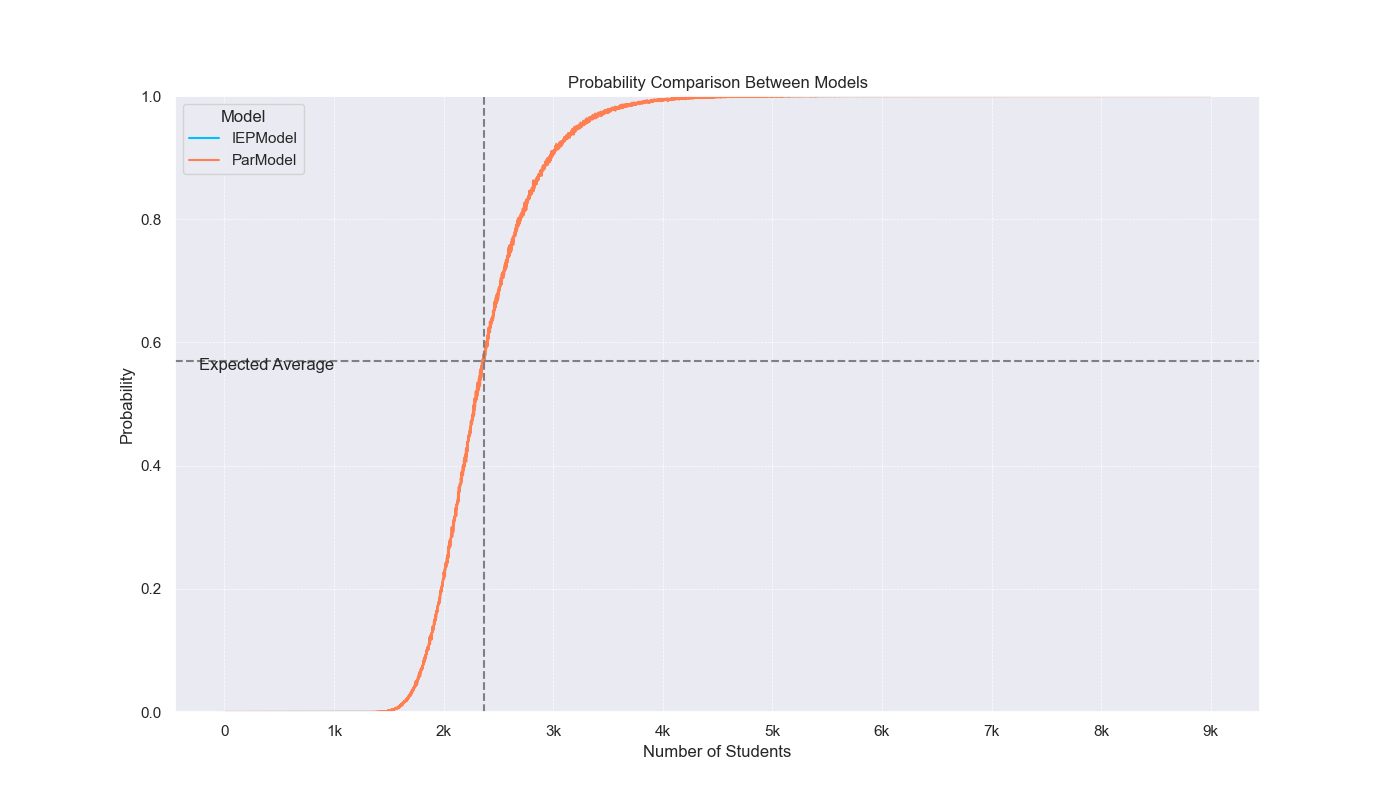
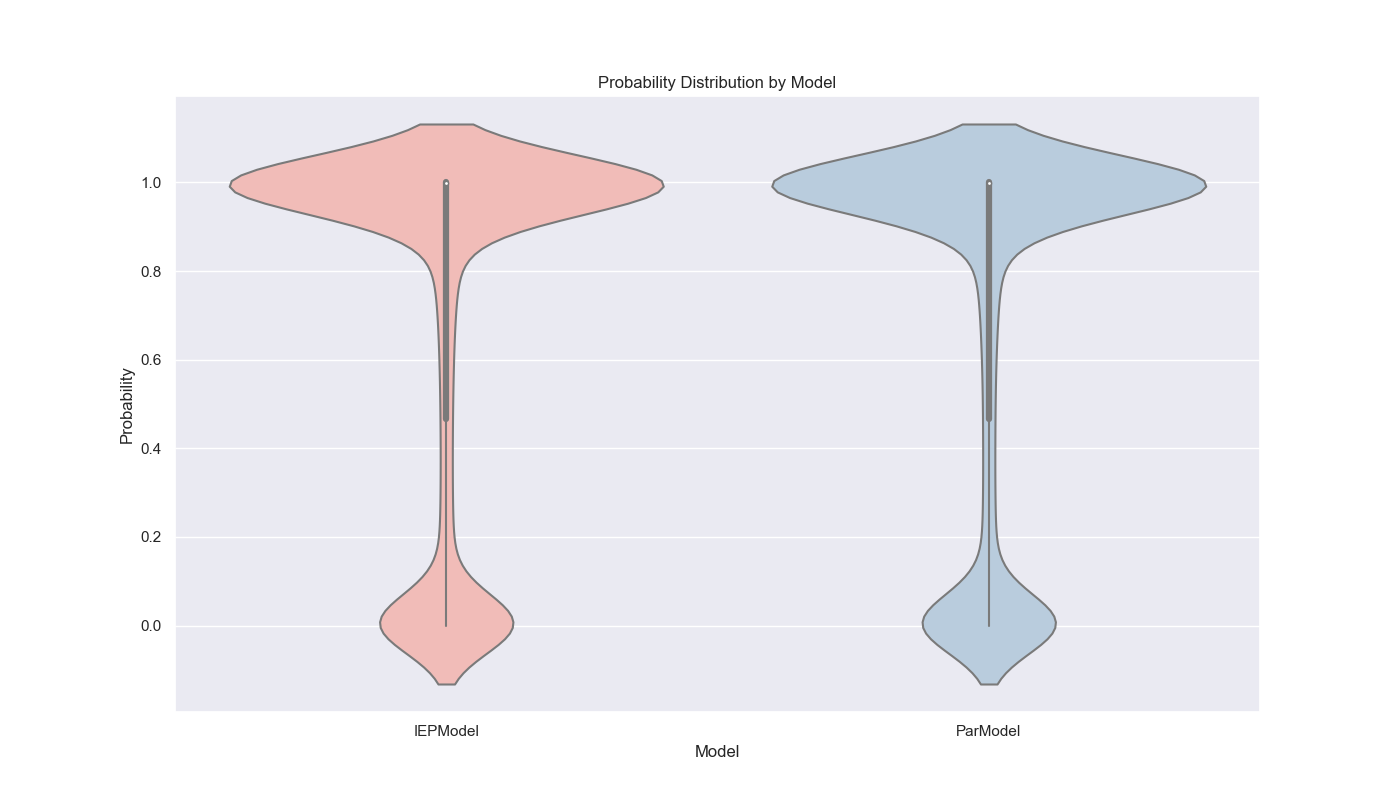

I like graphs because they help us visualize the data and see patterns that might not be immediately obvious from the numbers. In this case, we can see that the IEP model is much faster than the parallel model and that the probability of seeing all birthdays increases as the number of students increases. The violin plot also shows the distribution of probabilities for each model, with the IEP model having a narrower distribution than the parallel model. Finally, we can see that IEP scales linearly with the number of students, while the parallel model scales exponentially. Now, let’s move on to our final section and last model!
I read a paper and found…
Honestly, I was going to call it a day because although I said we would explore the original question, I didn’t know how to account for the fact that birthdays are not uniformly distributed. I had an idea on how to get the actual probabilities, and the last model (soon btw) was going to implement this based on data I got, but it felt like a cop-out. Or at least it was until I found a paper!
First, let’s talk about the assumptions we made. The most important thing to note is that birthdays are not uniformly distributed. The most famous blog about this can be found here by Roy Murphy. For instance, according to the data he collected, August is the most common month to have a birthday. This means that the probability of seeing all birthdays in a group of students is not simply $1 - \frac{m}{365}$, but rather a more complex function that depends on the distribution of birthdays. Moreover, Rice is a specific group of the general population, so it could have a different distribution of birthdays than the general population. It might be possible to answer the question well if I got specific data like zip code and birthdate, but due to ethical reasons, I totally don’t have that data. So that was a dead end — until I found this paper, Birthday paradox, coupon collectors, caching algorithms and self-organizing search by Philippe Flajolet.
So I read the paper (I totally didn’t just read the part that was relevant to my problem 🤧), and it turns out the Coupon Collector’s Problem can be generalized to non-uniform distributions. Specifically, in Theorem $4.1$, Dr. Flajolet gives us the equation:
$$ E(T) = \int_0^\infty \left(1 - \prod_{i=1}^m (1 - e^{-p_i t}) \right) dt. $$
This is equal to
$$ E(T) = \sum_{q=0}^{m-1} (-1)^{m-1-q} \sum_{|J|=q} \frac{1}{1 - P_J}, $$
Where $ m $ denotes the number of coupons to be collected, and $ P_J $ denotes the probability of getting any coupon in the set of coupons $ J $. Let’s prove this!
With the proof finished 😎, we will allow ourselves to use the theorem. Moreover, we will implement this as our last model. Let’s first talk about the data to generate the probabilities. The SSA (Social Security Administration) records birthdays in the US. Since we want to talk about Rice students, I got the data for 2002 to 2005 (sorry super seniors). I found this data here. Calculating the probabilities for each day was easy:
Now, we just gotta implement the formula to get the expected number of students needed to see all birthdays given the data from 2002 to 2005:
pub struct Flajolet {}
impl Simulation for Flajolet {
fn run(&self) -> Vec<f64> {
let probabilities = self
.get_probabilities()
.expect("failed to get probabilities");
let days = self.days() + 1; // 366 days
vec![self.flajolet(days, probabilities)]
}
}
impl Flajolet {
fn flajolet(&self, days: u16, probabilities: HashMap<u32, f64>) -> f64 {
let total_coupons = days as usize;
let mut expected_value = 0.0;
let mut memo = HashMap::new();
for curr_coupons in 0..total_coupons {
let sign = if (total_coupons - 1 - curr_coupons) % 2 == 0 {
1.0
} else {
-1.0
};
// we will memorize the product of the probabilities of the subsets
let subset_sum = match curr_coupons {
0 => {
// the probability of getting any coupon in the empty set
// is zero, so (1 - 0) = 1 and 1/1 = 1:
1f64
}
1 => {
let mut inner_sum = 0.0;
probabilities.keys().for_each(|&key| {
let val = 1.0 - probabilities[&key];
inner_sum += 1.0 / val;
memo.insert(vec![key], val);
});
inner_sum
}
_ => {
let mut inner_sum = 0.0;
for subset in probabilities.keys().combinations(curr_coupons) {
let subset = subset.into_iter().copied().collect::<Vec<_>>();
let rest = &subset[..curr_coupons - 1];
let new = [subset[curr_coupons - 1]];
let product = memo[rest] * memo[new.as_slice()];
let val = 1.0 / (1.0 - product);
inner_sum += val;
memo.insert(subset, product);
}
inner_sum
}
};
expected_value += sign * subset_sum;
}
expected_value
}
}
Now, all we have to do is modify our main function to run the Flajolet model and plot the results:
fn main() {
let model = flajolet::Flajolet {};
let result = model.run()[0];
println!("The expected value is: {}, This took {:?} to calculate", result.0, result.1);
}
After I ran it, I found the actual expected number of Rice Owls needed to see all birthdays, including leap days and real birthday distributions, was:
With that, we finally have a good enough answer to our original question 😉! I hope you enjoyed this exploration, and I hope you learned something new. Before we conclude, I wanted to compare an informed Monte Carlo simulation with the parallel model assuming equal probabilities for 366 days. I will use the probabilities we calculated from the data to run the simulation.
One Last Time: Informed Monte Carlo Simulation
Since we have the data, we can use the probabilities to make a more informed Monte Carlo simulation. I will use the same model as the parallel model, but instead of assuming equal probabilities for each day, I will use the probabilities we calculated from the data. Here is the code for the model:
impl Simulation for InformedModel {
fn run(&self) -> Vec<f64> {
let (days, simulations, students) =
(self.days() as usize, self.simulations(), self.students());
let days = days + 1; // 366 days
let probabilities = self
.get_probabilities()
.expect("failed to get probabilities");
let (keys, values): (Vec<u32>, Vec<f64>) = probabilities.into_iter().unzip();
// Create a WeightedIndex distribution based on the probabilities
let dist = WeightedIndex::new(&values).expect("Invalid probabilities");
students
.into_par_iter() // parallelize the outer loop
.map_init(
// init set and rand generator
|| (HashSet::with_capacity(days), rand::thread_rng()),
// for each number of students
|(birthdays, rng), num| {
(0..simulations)
.map(|_| {
birthdays.clear(); // so we don't have to allocate each time
birthdays.extend((0..num).map(|_| {
keys[dist.sample(rng)] // Generate a random day based on the probabilities
})); // add a random birthday to the HashSet
usize::from(birthdays.len() == days)
})
.sum::<usize>() as f64
/ simulations as f64 // sum the results of the simulations
},
)
.collect::<Vec<f64>>()
}
}
Now, that we are done with everything. I’d like to show you why I implemented the Simulation trait:
fn main() {
let models: Vec<Box<dyn Simulation>> = vec![
Box::new(basic::BasicModel {}),
Box::new(parallel::ParModel {}),
Box::new(iep::IEPModel {}),
Box::new(flajolet::Flajolet {}),
Box::new(informed::InformedModel {}),
];
for model in models.iter() {
let now = std::time::Instant::now();
let results = model.run();
println!("Model: {:?}", model);
for (num, result) in model.students().iter().zip(results.iter()) {
println!("Num Students: {}, Probability: {}", num, result);
}
println!("Elapsed: {:?}", now.elapsed());
}
}
See! We can easily run all the models and compare them (even if some won’t ever finish) and another pretty plot:

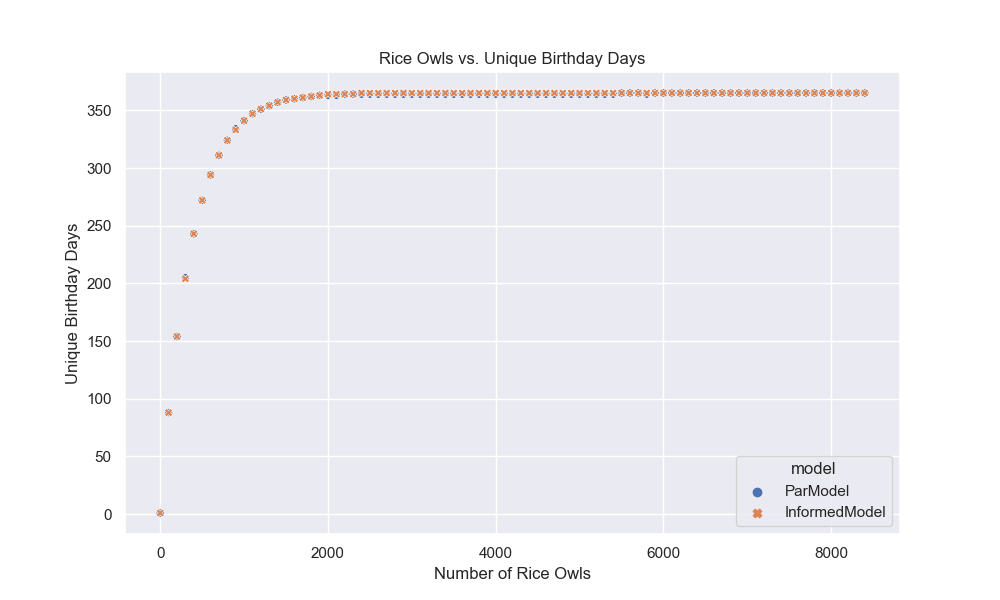

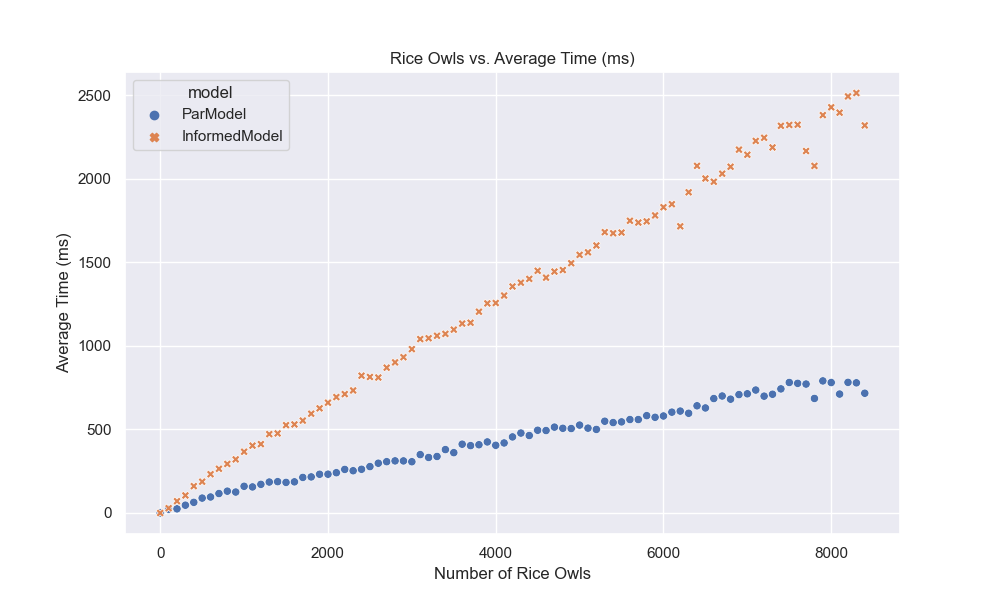
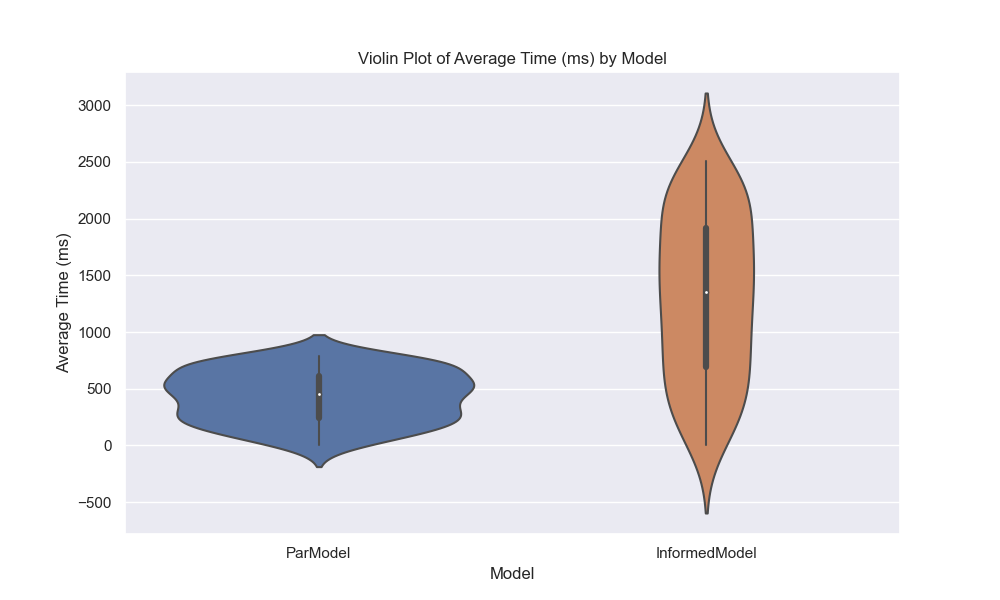
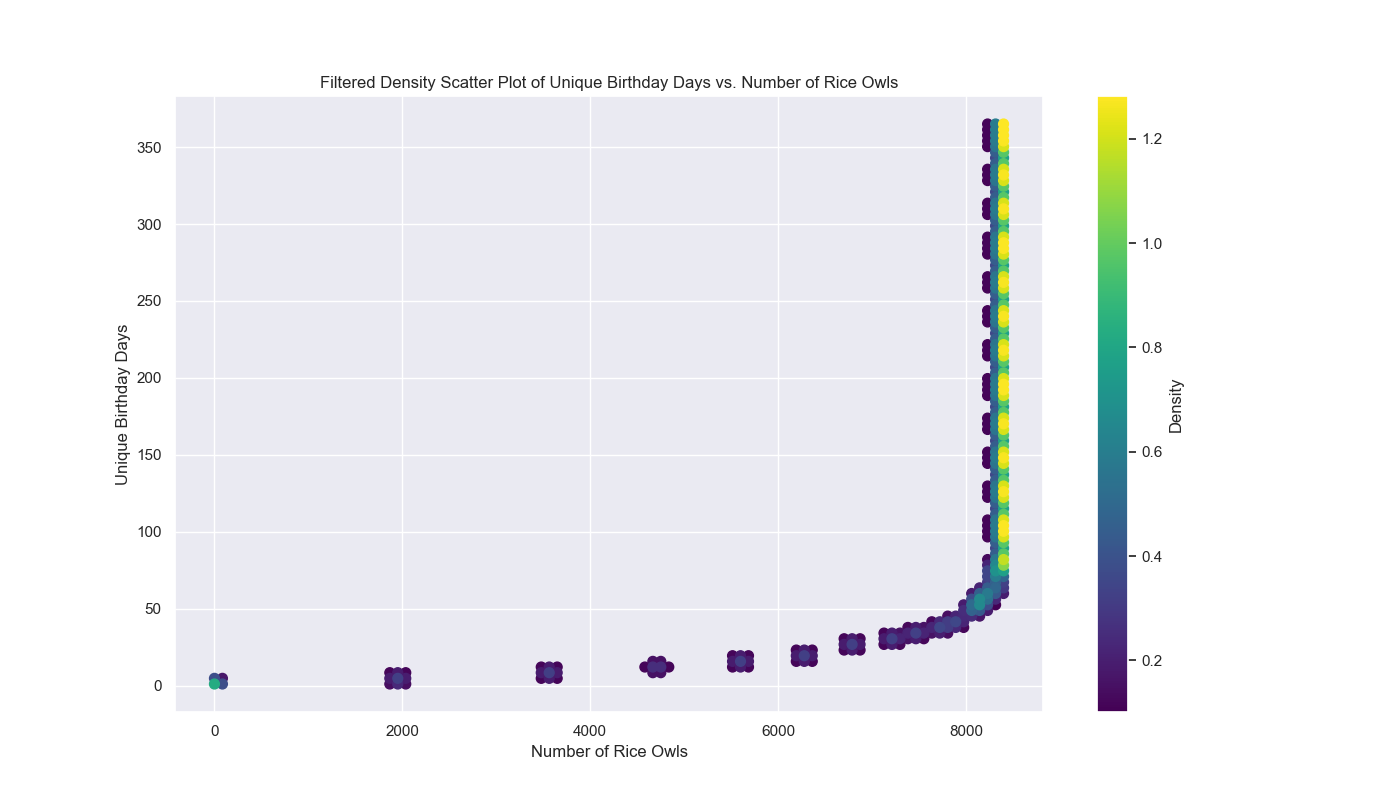
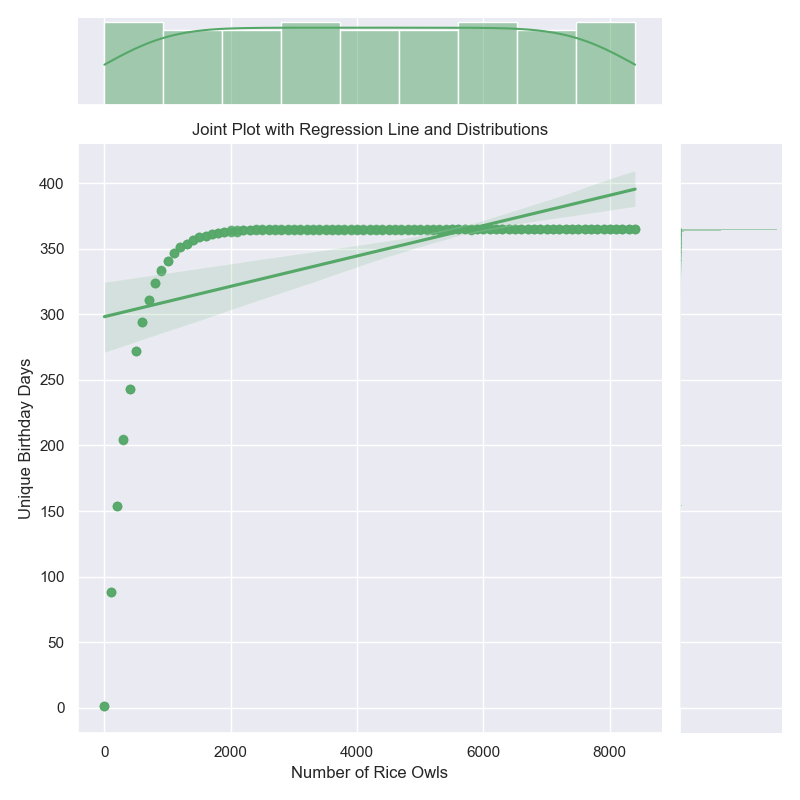
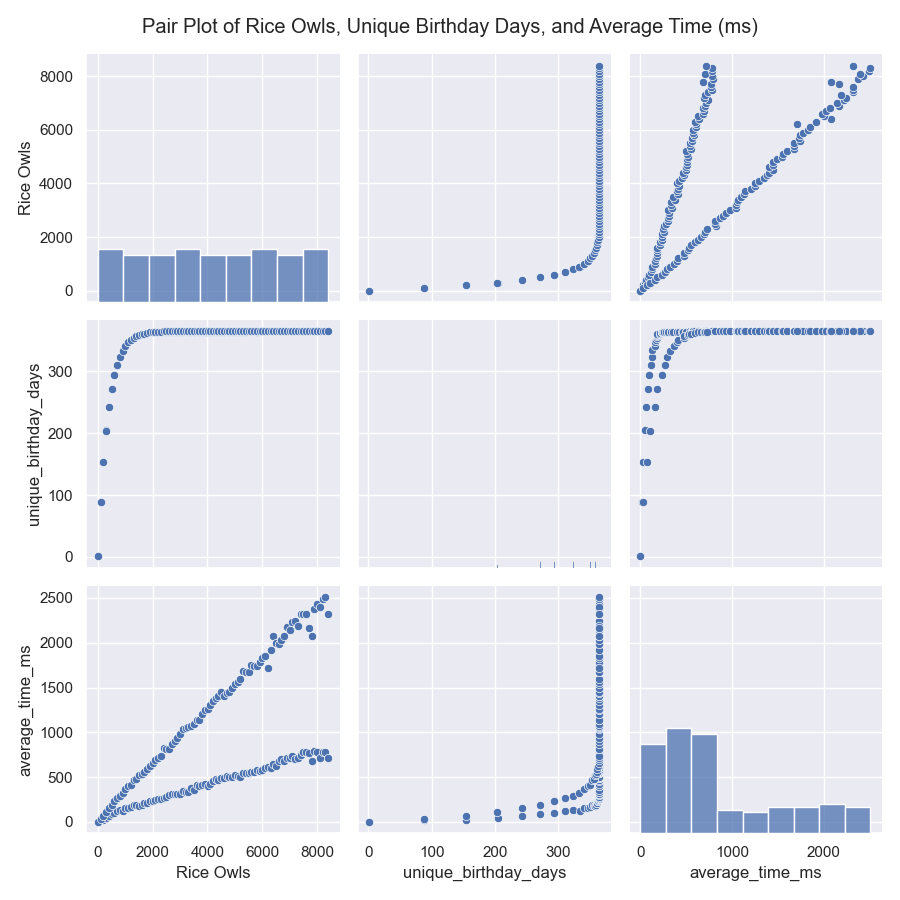
That said, we are at the end of our journey. In the end, we found a formula that works, but the power of today’s computation is holding me back 😔. While that may disappoint you, the reader, I know how to fix it: give me a polynomial time equation, and I’ll be back with an exact answer 😎. Anyways, I hope everything was clear; I tried my best. If you see any mistakes, know it’s not me who made a mistake; it’s you who needs a check-up/s (email me at [email protected] or write a comment below). Have a great year!
And then, the Physicst attacked
Sometimes, theory can only get us so far (please imagine me saying this while sobbing 😭😭😭). As a math major, I have always been told to pursue the idea of rigorousness, but we NEED an answer. I can’t provide that; however, I know someone who can. A physicist – one that is armed with computational tricks and pragmatism. Enter Wisha, a rising senior, a rustacean, and Rice’s best physicist5. Overhearing my frustration with the birthday problem, he decided to take matters into his own hands. He has given me a solution, and now it is my job to wrap his argument into a neat little package!
Revisiting our formula
Remember, we found that a generalized Coupon Collector’s Problem that assumes non-uniform distributions, however, for large $m$ ($366$ in our case), the formula Dr. Flajolet gave us is computationally infeasible. That being said, let’s take a closer look at the the first version of the formula:
$$ E(T) = \int_0^\infty \left(1 - \prod_{i=1}^m (1 - e^{-p_i t}) \right) \textrm{dt}. $$
To be finished…
Conclusion
Throughout this article, I came to realize that I hate stats. Thank you fizz, I’ll probably deregister from MATH 412: Probability Theory now. On a serious note, writing for a public audience – especially for math – is incredibly hard. If you read up to this point, I hope you enjoyed it.